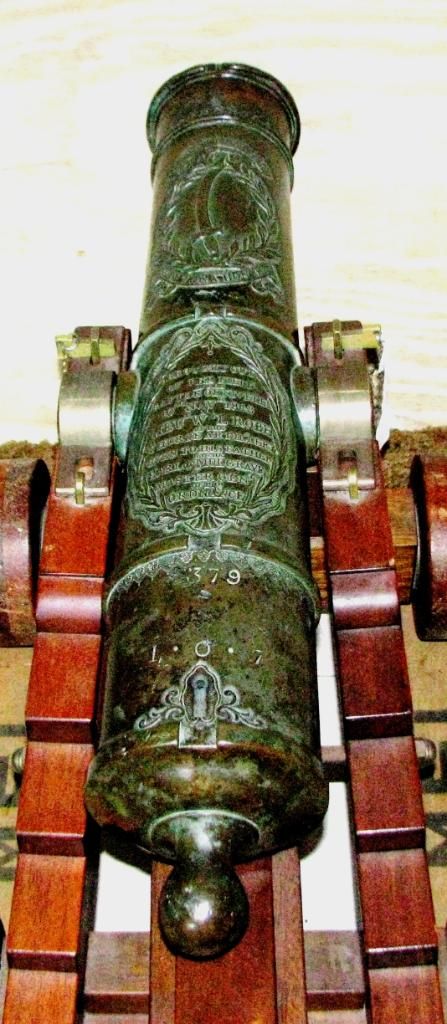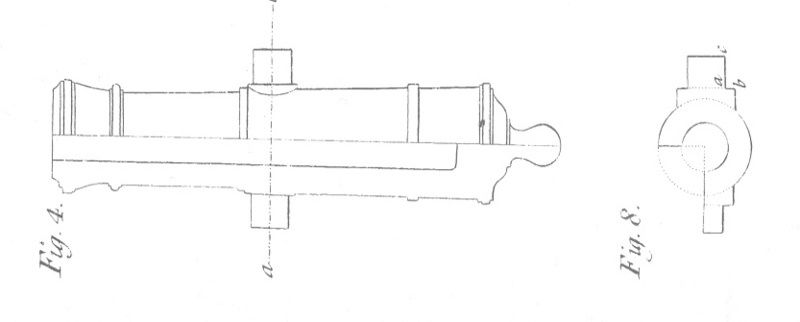
 |
|
|
#1 |
|
Member
Join Date: Jun 2006
Posts: 161
|
Some photos and a writeup that came with it. It is a Spanish Army mountain gun, 4 pounder, not a Portuguese weapon, unless the Portuguese exactly copied the Spanish model. Drawings of this model describing it as a 4-pounder mountain gun can be found in older Spanish texts. The "naval" type mounting the tube is shown on is purely decorative, it would have been on a two-wheeled field-type carriage in service. The bronze tube only weighs about 119 lbs. By looking down the bore you can tell it has done some firing, the bore has linear scratches where rough places on the shells cut little grooves. There's one deeper groove on the right side, looking at the muzzle, which must have come from a poorly-constructed canister round, which came apart in the bore and one of the balls cut into the bore a little.
Some day I will figure out exactly how this got out of Spain, into French hands, then into English hands. The writeup below has some of it but it isn't as tightly-wrapped a story as I'd like. Here's a brief slideshow, use password "attack." http://s17.photobucket.com/albums/b6...ountain%20gun/ If one photo is good enough, here's one:  "A FINE BRONZE PORTUGUESE [sic] 'MOUNTAIN GUN' FROM THE BATTLE OF NIVELLE, 1813, PRESENTED TO THE FATHER OF LIEUTENANT W.L. ROBE BY THE EARL OF MULGRAVE with four-stage barrel formed with raised mouldings, impressed '203' on the muzzle face, chiselled with a band of foliage ahead of the muzzle astragal fillet; a large cartouche with the Portuguese inscription VALOR Y LEALDADE above and the crest and motto of the Robe family ('a sabre erect between two branches of laurel crossing at the point and hilt of the sabre'; the motto CUM TOGA HONORIS) beneath; the second reinforce ring interrupted by a sight; the first reinforce chiselled with an early 19th century presentation inscription enclosed by fronds of foliage springing from a scallop shell; a further band of foliage chiselled behind the first reinforce ring and the numbers '379' and the '1.0.7' impressed behind, forward of the vent; chiselled with scrolls around the vent; moulded cascabel drawn-out to a button and a pair of plain trunnions; on a later stepped wooden carriage with four trucks 78cm; 30 3/4in barrel 7.5cm; 3in bore The presentation inscription reads: BROUGHT OUT OF THE FIELD AT THE BATTLE OF NIVELLE 10TH NOVR. 1813 BY LIEUT. WM. L. ROBE OF THE RL HORSE ARTILLERY GIVEN TO HIS FATHER BY THE EARL OF MULGRAVE MASTER GENL OF THE ORDNANCE The donor of this cannon, General Sir Henry Phipps, 1st Earl of Mulgrave, GCB PC (1755-1831) was Foreign Secretary 1805-06, First Lord of the Admiralty 1807-10 and Master General of the Ordnance 1810-18. Its recipient, Colonel Sir William Robe KCB, KCH (1765-1820), served in the West Indies and Canada in the 1780s, in Flanders 1793-94 and 1799 and at Copenhagen in 1807. In 1808 he went to Portugal to command the artillery in Sir Arthur Wellesley's first expedition and, between 1809 and until being invalided home following a severe wound late in 1812, served as a lieutenant-colonel of artillery in numerous battles and sieges in the Peninsular War, eventually receiving the Army Gold Cross with one clasp and being created a Knight of the Portuguese Order of the Tower and Sword (Stearn, 2004). Robe's eldest son, William Livingstone Robe, entered the Royal Military Academy Woolwich as a cadet in 1805 and was commissioned second lieutenant in the Royal Artillery in 1807, immediately joining an expedition to Göteborg and subsequently being posted to Gibraltar. From Gibraltar, he volunteered for service in Portugal, was promoted first lieutenant in June 1808 and joined his father in time to see his first action at the Battle of Vimeiro, 21st August 1808. After accompanying the army on the retreat to Corunna in 1809, Robe returned to the Peninsula to see his next action at the Battle of Pombal, 11th March 1811, and between that date and the ending of the Peninsular War in 1814 was in action against the enemy some thirty times, at the battles of Fuentes d'Oñoro, Badajoz, Salamanca, Nivelle and Nive as well as at lesser-known engagements. Late in 1813, Wellington began planning his assault upon France via the Pyrenees. His artillery commanders, realising that light guns would be needed to deploy in very mountainous terrain in support of the infantry, sought such weapons in order to form a small detachment of 'mountain artillery'. As the regimental historian records: 'Marshal Beresford brought a few 3-pounders from Lisbon; but it was found almost impossible to procure mules for them. Three guns of the same calibre, which had been taken from the French, had been temporarily equipped for single draught, and placed under the command of Lieutenant Robe, the son of the gallant officer who commanded at Roliça and Vimiera...A medley equipment was found for the guns brought from Lisbon, - the Artillery-men being Portuguese, but the drivers and mules being British. These guns were carried on the backs of the mules, and three of them were added to Lieutenant Robe's command.' (Duncan, 1873, p. 376) Robe's effective use of his mountain guns at the Battle of Nivelle, 10th November 1813, was such that his services were commended in dispatches by the Commander Royal Artillery, Lieutenant-Colonel Alexander Dickson, by Robe's divisional commander, Lieutenant-General Sir Henry Clinton KB, and ultimately by the Army commander, the then Marquess of Wellington. Dickson reportedly wrote, 'the mountain guns under Lieutenant Robe, and the Portuguese guns of similar calibre, were most active and useful, accompanying their respective corps during the day, and supporting the advance of their light troops.' (Duncan, 1873, p. 379). In a report to his corps commander, Lieutenant-General Sir Rowland Hill KB, of 11th November 1813 Clinton wrote: '...I must not omit to mention the good conduct of Lieutenant Robe of the Royal Artillery, who had been attached to the 6th division [Clinton's] in the command of the brigade of mountain guns: this officer by great exertion succeeded in getting his guns up to the height, and rendered himself useful in cannonading the enemy as the 2nd division drove him [the enemy] along his position.' (Wellington, 1861, p. 359). Hill sent Clinton's report to Wellington, who duly mentioned Robe in his dispatch of 13th November 1813 to Lord Bathurst, Secretary of State for War. Wellington's dispatch was printed in The London Gazette of 25th November 1813 and singled out for mention 'three mountain guns, under Lieutenant Robe' as being an effective part of Hill's corps on the British right flank. Later in the same dispatch, after recording the capture of 'fifty-one pieces of cannon', Wellington wrote: 'The artillery which was in the field was of great use to us; and I cannot sufficiently acknowledge the intelligence and activity with which it was brought to the point of attack, under the direction of Colonel Dickson, over bad roads through the mountains at this season of the year.' (Duncan, 1873, p. 379)." |
|
|

|
|
|
#2 |
|
(deceased)
Join Date: Sep 2008
Location: Bavaria, Germany - the center of 15th and 16th century gunmaking
Posts: 4,310
|
Thanks a lot for sharing, John,
This is doubtlessly a great piece of Portuguese bronze cannon! I bet 'Nando's planning on getting his home reconstructed just to house it!    Perfect documentation as well! Best, Michael |
|
|

|
|
|
#3 |
|
Member
Join Date: Jun 2006
Posts: 161
|
Thanks Michael. Hopefully Fernando can tell us whether the Portuguese Army had a model exactly like this, because as far as I can tell this one is really a Spanish mountain gun "of 4." The auction house, although knowledgeable in antique arms, doesn't have an overwhelming knowledge of artillery and I think made some bad assumptions on this one.
Here's the official Spanish Army drawing of their "mountain gun of four." 
Last edited by cannonmn; 28th December 2011 at 12:49 PM. Reason: add drawing |
|
|

|
|
|
#4 | |
|
(deceased)
Join Date: Dec 2004
Location: Portugal
Posts: 9,694
|
Quote:
However i can't resist to ask: why is this cannon claimed to be Portuguese by (at least) the seller ? because of the motto ? I don't think it stands for such presumption, for such wording is in fact a cocktail. VALOR is both spanish (castillian) and portuguese; Y is (only) spanish; and Lealdade is portuguese. Maybe who has put up the motto in this cannon was giving wings to his imagination ... and wasn't certainly a Spaniard or a Portuguese 
|
|
|
|

|
|
|
#5 |
|
(deceased)
Join Date: Sep 2008
Location: Bavaria, Germany - the center of 15th and 16th century gunmaking
Posts: 4,310
|
Grat piece and documentation, John,
Thanks! Best, Michael |
|
|

|
|
|
#6 |
|
Member
Join Date: Jun 2006
Posts: 161
|
Fernando, indeed they are wrong about the "Portuguese" piece. Lacking the linguistic skills you have, when I began research on this last year I wanted to see what the Portuguese used for their mountain artillery, since to me that was the quickest way to prove or disprove things. Steven Smith, a very active participant in the Napoleon Series forum, found photos of the Portuguese mountain guns and they are completely different in form from the heavily-engraved Spanish howitzer. I've searched high and low and found no Portuguese piece that resembled this one even slightly.
|
|
|

|
|
|
#7 |
|
(deceased)
Join Date: Dec 2004
Location: Portugal
Posts: 9,694
|
Most of the Portuguese Artillery used in the Peninsular War, namely that of the Lisbon defense lines ( Linhas de Torres) has been totally built in the national arsenals, being several fire mouths (as we often call cannonry) cast still in the second half XVIII by Bartolomeu da Costa (the same one who cast the howitzer with the pompous Chinese bed) and Italian born Carlos Napion.
We are talking about 150 fortifications (redoubts), held by 27.000 men and 380 artillery pieces, namely 24, 12, 9 and 6 pounders and 5 ½” howitzers. I wouldn’t know (right now) if campaign artillery had a different procedure in terms of provenance. … But i can post this link where, besides the plant drawing of various Portuguese foundries and uniforms of gunners, you can see, as from page 72, a few Portuguese Campaign pieces: a 1 pounder light cannon attributed to Master Bartolomeu (1798), a 3 pounder from 1797, a 9 pounder from 1802 (on the wrong bed) and a 6” howitzer from 1778. http://repositorio.uportu.pt/dspace/...e%20Anexos.pdf |
|
|

|
 |
|
|